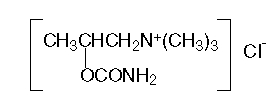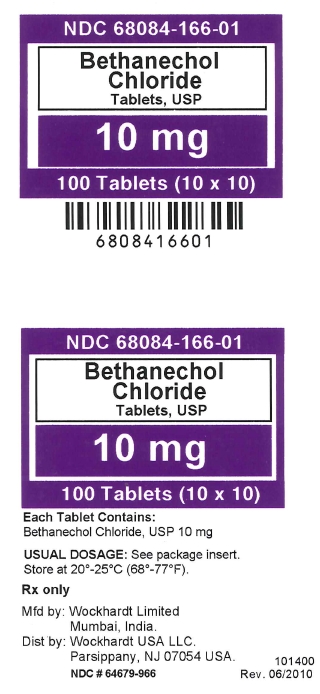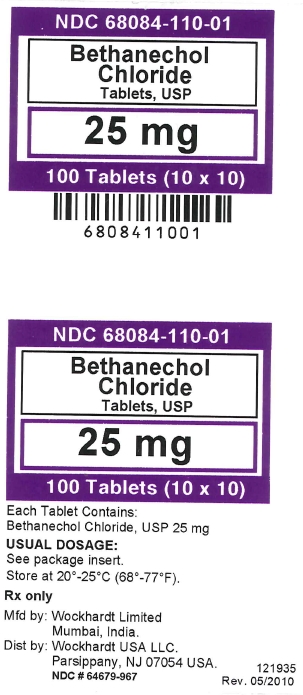BETHANECHOL CHLORIDE- bethanechol chloride tablet
American Health Packaging
----------
Bethanechol Chloride Tablets, USP
DESCRIPTION
Bethanechol chloride, a cholinergic agent, is a synthetic ester which is structurally and pharmacologically related to acetylcholine.
It is designated chemically as 2-[(aminocarbonyl)oxy]- N, N, N-trimethyl- 1-propanaminium chloride. Its molecular formula is C 7H 17ClN 2O 2 and its structural formula is:

It is a white, hygroscopic crystalline powder having a slight amine-like odor, freely soluble in water, and has a molecular weight of 196.67.
Each tablet for oral administration contains 5 mg, 10 mg, 25 mg or 50 mg of bethanechol chloride, USP. Tablets also contain the following inactive ingredients: anhydrous lactose, colloidal silicon dioxide, magnesium stearate, microcrystalline cellulose, sodium starch glycolate, (10 mg) FD&C Red # 40 and (25 mg and 50 mg) D&C Yellow # 10 and FD&C Yellow #6.
CLINICAL PHARMACOLOGY
Bethanechol chloride acts principally by producing the effects of stimulation of the parasympathetic nervous system. It increases the tone of the detrusor urinae muscle, usually producing a contraction sufficiently strong to initiate micturition and empty the bladder. It stimulates gastric motility, increases gastric tone and often restores impaired rhythmic peristalsis.
Stimulation of the parasympathetic nervous system releases acetylcholine at the nerve endings. When spontaneous stimulation is reduced and therapeutic intervention is required, acetylcholine can be given, but it is rapidly hydrolyzed by cholinesterase and its effects are transient. Bethanechol chloride is not destroyed by cholinesterase and its effects are more prolonged than those of acetylcholine.
Effects on the GI and urinary tracts sometimes appear within 30 minutes after oral administration of bethanechol chloride, but more often 60 to 90 minutes are required to reach maximum effectiveness. Following oral administration, the usual duration of action of bethanechol is one hour, although large doses (300 to 400 mg) have been reported to produce effects for up to six hours. Subcutaneous injection produces a more intense action on bladder muscle than does oral administration of the drug.
Because of the selective action of bethanechol, nicotinic symptoms of cholinergic stimulation are usually absent or minimal when orally or subcutaneously administered in therapeutic doses, while muscarinic effects are prominent. Muscarinic effects usually occur within 5 to 15 minutes after subcutaneous injection, reach a maximum in 15 to 30 minutes, and disappear within two hours. Doses that stimulate micturition and defecation and increase peristalsis do not ordinarily stimulate ganglia or voluntary muscles. Therapeutic test doses in normal human subjects have little effect on heart rate, blood pressure or peripheral circulation.
Bethanechol does not cross the blood-brain barrier because of its charged quaternary amine moiety. The metabolic rate and mode of excretion of the drug have not been elucidated.
A clinical study (Diokno, A.C.; Lapides, J.; Urol 10: 23-24, July 1977) was conducted on the relative effectiveness of oral and subcutaneous doses of bethanechol chloride on the stretch response of bladder muscle in patients with urinary retention. Results showed that 5 mg of the drug given subcutaneously stimulated a response that was more rapid in onset and of larger magnitude than an oral dose of 50 mg, 100 mg, or 200 mg. All the oral doses, however, had a longer duration of effect than the subcutaneous dose. Although the 50 mg oral dose caused little change in intravesical pressure in this study, this dose has been found in other studies to be clinically effective in the rehabilitation of patients with decompensated bladders.
INDICATIONS AND USAGE
Bethanechol chloride tablets are indicated for the treatment of acute postoperative and postpartum nonobstructive (functional) urinary retention and for neurogenic atony of the urinary bladder with retention.
CONTRAINDICATIONS
Hypersensitivity to bethanechol chloride tablets, hyperthyroidism, peptic ulcer, latent or active bronchial asthma, pronounced bradycardia or hypotension, vasomotor instability, coronary artery disease, epilepsy and parkinsonism.
Bethanechol chloride should not be employed when the strength or integrity of the gastrointestinal or bladder wall is in question, or in the presence of mechanical obstruction; when increased muscular activity of the gastrointestinal tract or urinary bladder might prove harmful, as following recent urinary bladder surgery, gastrointestinal resection and anastomosis, or when there is possible gastrointestinal obstruction; in bladder neck obstruction, spastic gastrointestinal disturbances, acute inflammatory lesions of the gastrointestinal tract, or peritonitis; or in marked vagotonia.
PRECAUTIONS
General
In urinary retention, if the sphincter fails to relax as bethanechol contracts the bladder, urine may be forced up the ureter into the kidney pelvis. If there is bacteriuria, this may cause reflux infection.
Information for Patients
Bethanechol chloride tablets should preferably be taken one hour before or two hours after meals to avoid nausea or vomiting. Dizziness, light-headedness or fainting may occur, especially when getting up from a lying or sitting position.
Drug Interactions
Special care is required if this drug is given to patients receiving ganglion blocking compounds because a critical fall in blood pressure may occur. Usually, severe abdominal symptoms appear before there is such a fall in the blood pressure.
Carcinogenesis, Mutagenesis, Impairment of Fertility
Longterm studies in animals have not been performed to evaluate the effects upon fertility, mutagenic or carcinogenic potential of bethanechol chloride.
Pregnancy: Teratogenic Effects
Pregnancy Category C: Animal reproduction studies have not been conducted with bethanechol chloride. It is also not known whether bethanechol chloride can cause fetal harm when administered to a pregnant woman or can affect reproduction capacity. Bethanechol chloride should be given to a pregnant woman only if clearly needed.
Nursing Mothers
It is not known whether this drug is secreted in human milk. Because many drugs are secreted in human milk and because of the potential for serious adverse reactions from bethanechol chloride in nursing infants, a decision should be made whether to discontinue nursing or to discontinue the drug, taking into account the importance of the drug to the mother.
ADVERSE REACTIONS
Adverse reactions are rare following oral administration of bethanechol chloride, but are more common following subcutaneous injection. Adverse reactions are more likely to occur when dosage is increased.
The following adverse reactions have been observed: Body as a Whole: malaise; Digestive: abdominal cramps or discomfort, colicky pain, nausea and belching, diarrhea, borborygmi, salivation; Renal: urinary urgency; Nervous System: headache; Cardiovascular: a fall in blood pressure with reflex tachycardia, vasomotor response; Skin: flushing producing a feeling of warmth, sensation of heat about the face, sweating; Respiratory: bronchial constriction, asthmatic attacks; Special Senses: lacrimation, miosis.
Causal Relationship Unknown: The following adverse reactions have been reported, and a causal relationship to therapy with bethanechol has not been established: Body as a Whole: malaise; Nervous System: seizures.
OVERDOSAGE
Early signs of overdosage are abdominal discomfort, salivation, flushing of the skin (“hot feeling”), sweating, nausea and vomiting.
Atropine Sulfate is a specific antidote. The recommended dose for adults is 0.6 mg. Repeat doses can be given every two hours, according to clinical response. The recommended dosage in infants and children up to 12 years of age is 0.01 mg/kg (to a maximum single dose of 0.4 mg) repeated every two hours as needed until the desired effect is obtained or adverse effects of atropine preclude further usage. Subcutaneous injection of atropine is preferred except in emergencies when the intravenous route may be employed.
The oral LD 50 of bethanechol is 1510 mg/kg in the mouse.
DOSAGE AND ADMINISTRATION
Dosage must be individualized, depending on the type and severity of the condition to be treated.
Preferably give the drug when the stomach is empty. If taken soon after eating, nausea and vomiting may occur.
The usual adult oral dose ranges from 10 to 50 mg three or four times a day. The minimum effective dose is determined by giving 5 to 10 mg initially and repeating the same amount at hourly intervals until satisfactory response occurs, or until a maximum of 50 mg has been given. The effects of the drug sometimes appear within 30 minutes and are usually maximal within 60 to 90 minutes. The drug effects persist for about one hour.
If necessary, the effects of the drug can be abolished promptly by atropine (see OVERDOSAGE)
HOW SUPPLIED
Bethanechol Chloride Tablets USP
| Strength | NDC# | Pack | Description |
| 10 mg | NDC 68084-166-01 |
Unit dose packages of 100 (10 x 10) |
Pink, oval shaped tablets debossed with W966 on one side and breakline. |
| 25 mg | NDC 68084-110-01 |
Unit dose packages of 100 (10 x 10) |
Light yellow, oval shaped tablets debossed with W967 on one side and breakline on the other side. |
Store at 20 - 25ºC (68 - 77ºF).
Manufactured by:
Wockhardt Limited
Mumbai, India.
Distributed by:
Wockhardt USA LLC.
20 Waterview Blvd.
Parsippany, NJ 07054
USA.
Repackaged by:
American Health Packaging
Columbus, Ohio 43217
8016601/050810
| BETHANECHOL CHLORIDE
bethanechol chloride tablet |
||||||||||||||||||||
|
||||||||||||||||||||
|
||||||||||||||||||||
|
||||||||||||||||||||
|
||||||||||||||||||||
|
||||||||||||||||||||
|
||||||||||||||||||||
| BETHANECHOL CHLORIDE
bethanechol chloride tablet |
||||||||||||||||||||
|
||||||||||||||||||||
|
||||||||||||||||||||
|
||||||||||||||||||||
|
||||||||||||||||||||
|
||||||||||||||||||||
|
||||||||||||||||||||
| Labeler - American Health Packaging (929561009) |
| Establishment | |||
| Name | Address | ID/FEI | Business Operations |
|---|---|---|---|
| American Health Packaging | 007914906 | repack(68084-166, 68084-110) | |

